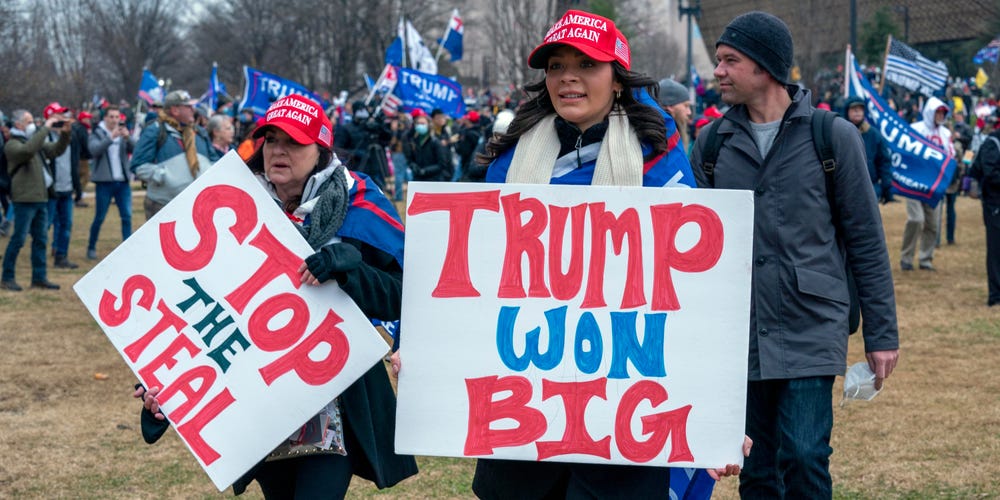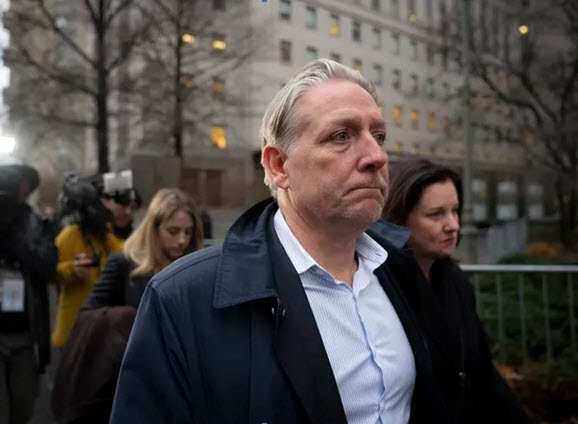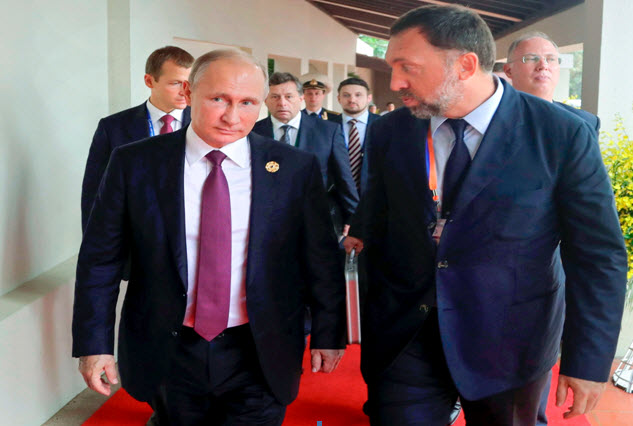Trump Kept Secret a Study That Found No Fraud in 2020
In the early morning hours after the 2020 election, Donald Trump told his supporters “Frankly, we did win this election. We did win it”. Thus began “The Big Lie”, his campaign that the election had been stolen. Only he said it. Millions believed it because he said it.
But Trump was desperate to come up with something that could make his myth seem true, so his campaign contracted with Berkeley Research Group, a California outfit that helps organizations in “disputes and investigations” to look for the fraud that supposedly cost Trump his presidency. This effort was entirely unknown until The Washington Post broke the story in early February, unknown because Berkeley came up with nothing, a result displeasing to Trump that he and those around him have kept secret for over two years. In the two months between the election and the January 6th insurrection, about a dozen Berkeley researchers studied results in six “battleground” states where voting was close. The Post quotes one of four sources, “a person familiar with the work who, like others, spoke on the condition of anonymity”: “They looked at everything: change of addresses, illegal immigrants, ballot harvesting, people voting twice, machines being tampered with, ballots that were sent to vacant addresses that were returned and voted, literally anything you could think of. Voter turnout anomalies, date of birth anomalies, whether dead people voted. If there was anything under the sun that could be thought of, they looked at it.” There were the usual anomalies, irregularities, mistakes common to all elections given the huge numbers involved but these “actually went in both directions”, said one informant. The rare fraud is usually of what we’ll call the mom-and-pop variety: pop died a few weeks before the election, mom knew how he would have voted and turned in his ballot.
Berkeley tested a dozen hypotheses that the Trump camp wanted examined but nothing of significance was found nor was there anything that would have changed the outcome in any of the states, even though it would not have taken much to flip the election. Biden won Wisconsin, Michigan, and Pennsylvania by a combined total of only 77,744 votes. Had those states gone for Trump, 46 of Biden’s 306 votes would been switched to the other column to give Trump 272 votes, 2 more than the majority needed to make him president again. wrong answer
Berkeley briefed then-President Trump on its findings late in December of 2020 in a conference call. “The call grew contentious”, The Post was told. Mark Meadows said he still believed that Trump had won the election and Trump, the Berkeley report kept secret, has gone on saying so ever since. On the same day this is written, in an interview on Trump lawyer Jenna Ellis’s podcast, he repeatedly claimed that Democrats “cheated” to steal the 2020 election. In reaction to The Post‘s exposure, Berkeley Research Group wouldn’t comment other than stating company policy to “provide independent and objective factual analysis” and “as a matter of firm policy, we do not comment on client engagements or on privileged and confidential matters.” Trump spokesman Steven Cheung offered a bizarre evasion: “President Trump received a record breaking number of votes, the most of any sitting president in the history of the country. Anyone who takes a look at Joe Biden sleeping through his presidency and his abysmal approval numbers knows who really won the election.” legal ramifications? We’ll guess not.
A legal matter is whether the former president knew he lost the election or whether he believed the delusion he had created. The inference is that one can be deemed innocent of a crime if he or she believes in a different reality. Not you, not me, of course, only this former president is accorded that special deference, so it seems.
To get around that, prosecutors have had to collect instances of Trump’s contacts telling him that he lost, so as to amass proof that he cannot maintain that he didn’t know. But could not Mr. Trump simply argue that they were just venturing an opinion no more valid than his own? The in-depth Berkeley study is another matter, the most conclusive evidence yet that Trump cannot feign ignorance of his loss. And the reason that matters is, among the many crimes Trump is thought to have committed, prosecutors may now have in hand proof of fraud against the American people Trump has committed by persuading the millions of them of The Big Lie of a stolen election and thereby the incalculable damage of sowing distrust in the nation’s democratic elections. the damage lives on
Millions of Trump followers continue to believe the election was stolen. One need only look who they have sent back to Congress in the 2022 midterms. Based on their statements compiled before the election by the website FiveThirtyEight, 127 who had stated belief in a stolen election won seats in the House, the Senate, and governorships. And with near total overlap, those returned to Congress had voted on January 6th, 2021, had voted to decertify the electoral college slates submitted by the states with the objective of throwing to decision to the House, where Trump would have been declared the winner.
In a 5,500 word article in October — found here — we deflated claims of any significant quantity that the so-called deniers were relying on as proof the election was stolen. That treatise, we think, was determinative.
But the problem with that approach is that deniers don’t think anything through. Each sighting — the box under the table in Georgia, the 18-wheeler in Pennsylvania, etc. — is declared proof of fraud, all the ballots could only be for Biden, are somehow enough to steal the election, and it falls to the truth brigade to spend the effort and time to disprove what are fabrications. How not to steal an election
Instead, replace the nonsense with common sense: Focus on the mechanics of elections. How do you create imaginary people? Where is the logic of believing in Trump’s complaint of, for example, dead voters — 5,000 in Georgia, 1,500 in Nevada? How does a small conspiratorial army (with no one ever having a crisis of conscience, then or since, to spill the beans) comb through county records to find 5,000 dead people without raising suspicion, and then check each of them to see if they have not been pruned from the voter roles so that a phony ballot will count? Trump wouldn’t be so stupid as to do that. He’s counting on you being dunce enough to fall for dead voters.
Doesn’t anyone wonder about the quantities? To flip the results in closely competitive states calls for a few hundred thousand phony ballots. Trump disciples would claim that 78,000 fake votes for Biden in the three states we cited above were all that were needed for the Democrats to steal the election. But the conspirators could not know in advance how many phony Biden ballots would be needed in each of six tight states — the three above plus Georgia, Arizona, Nevada — so that there would be enough in each of them to overturn which of them that proved to be tight. That adds up to impracticably massive quantities of illegal votes that would be needed.
About those masses quantities of needed phony ballots. How would that be kept silent? In the thousands of polling places across the country, for a ballot cast in-person or mailed in to be counted, a person must have registered to vote. Ballots are checked against that registry and once checked a redundant vote by that person is blocked (and flagged as illegal).
Each of those hundreds of thousands of ballots must be filled in with the unique names, addresses, and signatures of actual registered voters. If the data for fill-in could be obtained — which needs to span several states and the hundreds of polling places where those voters live — how do the conspirators recruit hundreds of people to fill out the ballots, all of them willingly committing fraud and not one of them blowing a whistle? That’s the premise of the film “2,000 Mules”. Its title tells us of the hypothesis that 2,000 people were recruited to collect and deliver fraudulent ballots to drop boxes. But not one of them has come forward to confess to the scheme because, while the deniers even went to the extent of making a theater-release movie, it was just an idea was based on nothing but conjecture. Doesn’t there have to be two of everyone? Let’s anyway say there were enough souls angry enough at Trump and his party to run the risk — as much as five years in prison plus fines, each fraudulent ballot a separate count — of filling out scores of phony ballots for Biden. What happens when the ballot reaches the polling place where the actual person has already voted, or he or she goes to the polling place and is told the vote has already been cast? How does this plot work when inevitably an uproar arises from tens of thousands of voters who have collided with the fake ballots in their name and art outraged to discover that their votes were stolen? Instead, there was silence. There were no thousands of fake ballots conflicting with actual voters in 2020. Instead it was Trump who supposedly knows of all this double-voting — 42,284 in Nevada! How stupid are Americans to be taken in by this?
Okay, so it must have been the machines. Trump’s entire premise was that masses of fraudulent mailed ballots would steal the election, but we’ve shown that cannot work. The strategy turned to nonsensical allegations by Trump and members of his campaign that voting machines, such as those made by Dominion Voting Systems, used decade old Venezuelan software that flipped Trump votes to Biden. None of them had any evidence — the claims are loony — much less the slightest knowledge of the software and how it works, and their defamation caused Dominion to file eight lawsuits seeking more than $10 billion in damages against Fox News, and other networks, corporations and individuals.
The software is sealed in, and likely in compiled form (zeroes and ones) that is entirely unintelligible. Even if in a readable coding language, who would there be in countless polling locations to understand and tamper with it? Perhaps they could test-run batches of ballots and compare the tally with hand counts. Which did happen, but not in batches, in entire recounts in which machine and manual counts came out remarkably close.
John Poulos, Dominion’s founder and CEO, wrote an op-ed in The Wall Street Journal which shredded the absurd accusations by outlining the security of how U.S. election systems actually work: ” Third-party test labs, chosen by the bipartisan Election Assistance Commission and accredited by a program of the National Institute of Standards and Technology, perform complete source-code reviews on every federally certified tabulation system. States replicate this process for their own certifications.” No single company in the American electoral systems could surreptitiously change votes, said Dominion in a 15-point rebuttal of rightwing conjurings. Such a plot would require “collaboration of thousands” of poll workers, auditors and contractors that support state information technology and voting systems.
That leaves election workers. The most reprehensible and deranged are those who think election workers rigged Biden’s presidency. Setting aside their psychosis, the illogic reveals them as the most stupid of the deniers. How do they imagine that certain poll workers had connected with others across polling stations across their state to form a cabal to volunteer only to be able to change votes? How would that be done? Somehow altering the ink marks on paper ballots? How would they change touch-screen selection? And we’ve already dealt with the fantasy of fiddling with the software in the sealed machines.
These deviants have gone after poll workers seemingly at random, finding where they live, stalking them, causing some to move, to live with relatives, fearful for their safety, even their lives. How do we rid our country of them?
And by the way, one of those deviants is Donald Trump, who has persistently attacked the Georgia worker who moved the box from under the table.
Duped by The Big Lie




